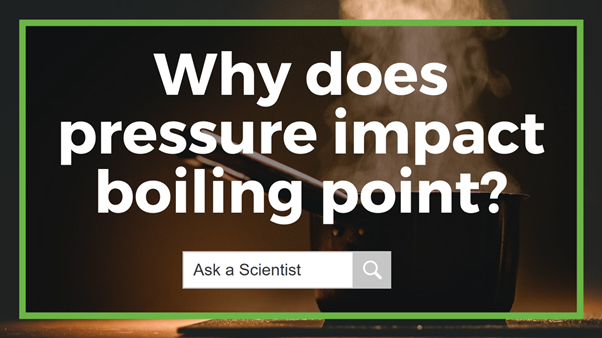Instrument Choice Experiment: Does Altitude Impact the Boiling Point Of Water?

The boiling point of water is 100°C...or is it?
In this experiment, we boil water at different altitudes to demonstrate the impact that atmospheric pressure has on the boiling point of water.
The Science Behind the Experiment
It is common knowledge that the boiling point of water is 100°C; however, certain factors can alter this, and one of these factors is atmospheric pressure. You might be surprised to learn that the 100°C boiling point of water applies only at sea level, and as altitude increases, this point reduces.
Why does this happen?
We first need to define what we mean by "boiling point". Boiling point is the temperature at which the pressure exerted by the vapour of a liquid equals the pressure exerted upon the liquid by its surroundings. From this moment, the liquid will change into a vapour.
As altitude increases, atmospheric pressure decreases. So, when the external pressure exerted upon a liquid reduces, the vapour pressure required to induce boiling reduces too, and so does the boiling point.
For approximately every 150 metre increase in altitude, the boiling point of water will lower by approximately 0.5°C, see figure 1 (below).
| Altitude in metres (m) | The boiling point of water (°C) |
| 0 m | 100°C |
| 150 m | 99.5°C |
| 305 m | 99°C |
| 610 m | 98°C |
| 1524 m | 95°C |
| 1829 m | 94°C |
| 2438 m | 91.9°C |
| 3048 m | 89.8°C |
| 3658 m | 87.6°C |
| 4267 m | 85.5°C |
| 4572 m | 84.5°C |
The Experiment
For this experiment, we will test the boiling point temperature of bottled water near sea level and again in the Adelaide Hills at an elevation of 440 metres above sea level.
Materials Used
- Room Temperature Water (One litre of bottled water from the same source used for consistency)
- Thermometer (We used the PT100 Waterproof Thermometer with Probe - C370-IC)
- Portable burner
- Pot
Method
- At sea level, pour 500mL of room temperature bottled water into the pot.
- Place the thermometer into the water.
- Turn on the burner.
- Observe the water. When boiling occurs, record the temperature.
- At a higher altitude, pour around 500mL of room temperature bottled water into the pot.
- Place the thermometer into the water.
- Turn on the burner.
- Observe the water. When boiling occurs, record the temperature.
Results
| Altitude | Boiling Point Temperature |
| 4m | 100°C |
| 440m | 98.2°C |
The boiling point of our bottled water was 98.2°C when we were at an altitude of 440m and as expected, 100°C when we located our liquid sample at sea level.
Conclusion
As our results indicate, the boiling point of water reduces as altitude increases. We attribute the reduction in boiling temperature to the effect that reduced atmospheric pressure has on the boiling point of water.
Want more information on any of the products mentioned above? Speak with an Instrument Choice Scientist! We're here to help! Call 1300 737 871 or email [email protected].
Also interesting
We don’t mean to alarm you, but Michael Buble Christmas carols are wafting on the breeze, while shops, houses, and trees adorned in dazzling lights and decorations are appearing everywhere. It’s nearly December, and that means Christmas is just around the corner!
One of the challenges we face at this time of year is choosing gifts. It can be even more difficult if you have a friend or family friend who has everything and loves gadgets (we understand the personality type perfectly!)Good news, we can help with that! Your Instrument Choice team has assembled some gizmos that make ideal Christmas gifts for the scientifically-minded.

With more than 40,000 satisfied customers, Instrument Choice is a pioneer and the leading provider of scientific instruments online. Our online “supermarket” focusses on devices that measure, test and log scientific environmental data.


